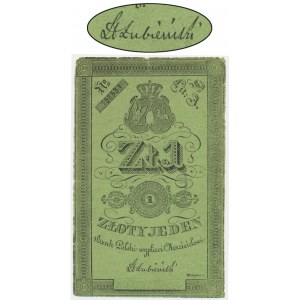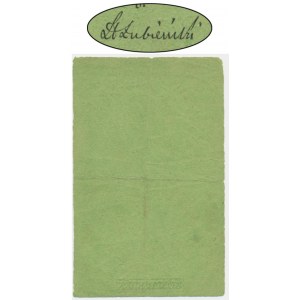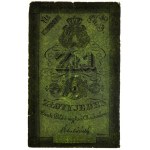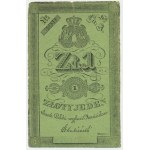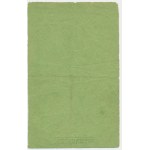Insurgent gold coin signed by Lubienski. The rarest variant printed on thin paper.
A very nice and pleasant piece, definitely better than the technical grade indicates.
Broken in four and minor edge cuts. Minor clearance on the line of the vertical fracture.
Banknote without the slightest sign of conservation corrections. The paper is clean, the printing is intense green.
Dry stamp very readable, despite the low weight of the paper used for printing.
A banknote with a lot of printing freshness, nice in presentation, which, combined with the rarest variant with Lubienski's signature and the thin paper used for printing, allows us to assume that there will be no shortage of takers for such an attractive piece.
In 1815 the Kingdom of Poland was established, united by a personal union with the Russian Empire. State separation was abolished after the fall of the November Uprising. Only administrative separateness was retained. After the January Uprising, it too was abolished.
The idea of introducing paper money in the Kingdom of Poland appeared in 1821. In this way it was wanted to pay off the debts of the governments of the Duchy of Warsaw, which had to be settled by the Central Liquidation Commission. On April 15, 1823, Tsar Alexander I issued a decree under which he established cash tickets in Polish zlotys.
Denominations: 5, 10, 50 and 100 zlotys with the issue date of 1824 were printed at the Assignment Factory in St. Petersburg. Originally, a commission of 2% of their value was to be deducted when they were exchanged for bullion coins. In the end, it was not decided to put them into circulation. This was done only by the Bank of Poland, established in 1828.
After the opening of a bank of issue in the Kingdom of Poland, the total circulation of paper money proved too small. In addition, the tickets printed in 1824 were made on poor-quality paper and were easily damaged. For this reason, tickets with a new design were prepared with an issue date of May 1, 1830. Unlike previous issues of paper money, these tickets won full public trust. Contributing to this was the possibility of permanent and full exchange for bullion money at the bank's cash desks without deducting commissions when exchanging them.
Cash tickets from 1824 were in the form of a lying rectangle surrounded by a decorative frame. Their designs were modeled on Russian asignats. They were the first paper money printed on both sides. At the top, in the center of the frame, there is a circular field with the coat of arms of the Kingdom of Poland. In 1828, new paper money designs were created on which the White Eagle was missing. It can be found on the dry seal of the Bank of Poland as part of the coat of arms of the congressional kingdom.
After the outbreak of the November Uprising, the population hoarded bullion money, which forced the issuance of paper money of low denominations. The national government authorized the Bank of Poland to issue denominations of 1 and 2 zlotys. However, only the lower denomination with the annual date of 1831 was put into circulation. This was the only banknote of the sovereign Polish state in the 19th century.
